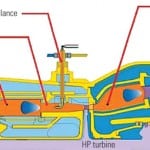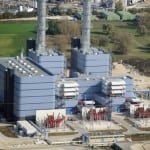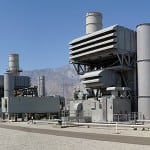The newest member of the 60% thermal efficiency combined cycle club is GE Energy’s FlexEfficiency 50. In an era when flexible grid operation is growing in importance, this 50 Hz, single-shaft combined cycle also holds its design point efficiency down to 87% load and features turndown to 40% of rated load.
Have you noticed the different approaches used by U.S. and European utilities to purchase and install gas-fired combined cycle plants? Neither approach is intrinsically better; it is just a difference in project philosophy.
In the U.S., the project begins by sourcing major components by competitive bid, an engineering company decides how to flange all the parts together, a control equipment supplier integrates operation of all the parts, and a contractor assembles all the parts to produce a working plant. Sometimes the contractor takes the lead under an engineer-procure-construct contract, and sometimes the owner maintains control of the project. There are variations, but this has been the general approach in the past.
In Europe (and many other parts of the world, typically, 50 Hz regions), the plant owner purchases the complete plant from a major equipment supplier, and that supplier handles the entire project, normally self-supplying all of the major equipment on the project, including the plant control system.
Class Warfare
Understanding the different procurement practices is helpful when viewing the latest high-efficiency combined cycle designs. Today, several suppliers have, or will soon have, gas-fired plant designs that are pushing the 60% effi ciency barrier. Each of those 50 Hz plants features an integrated design based on that supplier’s equipment. That is very good news for utilities that are in the market for a new 50 Hz plant. That is not such good news for utilities that are in 60 Hz countries, like those in the Western Hemisphere.
The latest addition to the 60% thermal efficiency class of plants is GE Energy’s FlexEfficiency 50 plant design. As with the other plant options, the base FlexEfficiency 50 operates at 50 Hz and features an array of GE Energy–supplied equipment optimized for efficiency and rapid response, particularly suited for a grid with intermittent renewable generation. Unlike the other offerings, the FlexEfficiency 50 was designed from the ground up with high ramp rates to meet fluctuating demand and the ability to be turned down to low part loads while maintaining emissions (Figure 1).
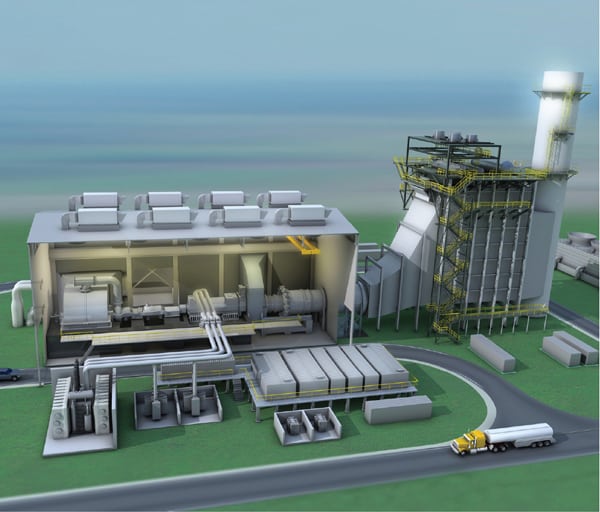 |
| 1. Flexible response. The GE Energy 510-MW FlexEfficiency 50 was designed to provide grid regulation services to balance the intermittent output of renewable generation. The fast-responding, single-driveline plant is designed to fit in a space as small as 10 acres and can be constructed in 24 months. Source: GE Energy |
New Design Features
A few years ago, GE Energy began studying grid behavior and economic factors when large amounts of renewables are connected to a grid, particularly in Western Europe, China, India, and Brazil. The conclusions reached by its many studies suggested that future utility-scale combined cycle plants must be much more flexible in dispatch, must start and ramp up (and down) load quickly, and must have deep turn-down capability—all without large efficiency or cost-of-maintenance penalties. Another conclusion: As the amount of renewable energy resources added to a particular control area of the grid increases, so does the need for regulation capacity, in installed megawatts and duration of operation.
GE Energy invested about $500 million in research and development to develop the 510-MW FlexEfficiency 50 product to meet the challenge of renewable integration. Four distinctive operational features of this plant were specified based on that research:
- Efficiency. The plant has an advertised thermal efficiency of 61%, and that efficiency is maintained down to about 87% load.
- Response. The plant’s ramp rate is an incredible 50 MW/minute, twice that found in most operating combined cycle plants today.
- Turndown. The plant can turn down to 40% of its baseload output while meeting its air emissions guarantees. Work continues to reduce that number to 20% of baseload rating.
- Fast startup. The entire combined cycle plant can start and be online and almost to full load in less than 30 minutes, for a hot start (Figure 2).
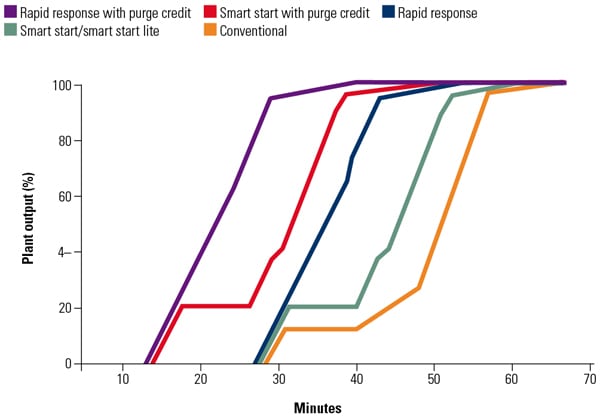 |
| 2. Fast company. Full-load operation of the FlexEfficiency 50 combined cycle plant is possible in as little as 30 minutes. A variety of other starting options are available to the plant operator, depending on the needs of the grid. The start button was pushed at time zero on this chart. Source: GE Energy |
Optimized Designs
In the past, integrated plant designs meant assembling a plant constrained by that company’s standard list of products, adding supervisory controls, and taking the product to market. GE Energy did use familiar components, although each was optimized to meet the overall plant’s operation and efficiency goals discussed above. Let’s explore the equipment selected for the FlexEfficiency 50 plant design.
Combustion Turbine. The FlexEfficiency 50 is based on the venerable 9FB (version.05) combustion turbine (CT). This CT version includes a “speed-scaled” version of the 7FA CT with field-replaceable compressor blades, an evolutionary step from GE’s aircraft engine lineage. The engine uses the familiar dry low-NOx 2.6+ combustion system, but with a couple of changes. This version includes “removal of the diffusion passage in each outer nozzle and the addition of a fuel passage upstream of the swizzles,” according to GE Energy. A swizzle is the combination of a nozzle and a swirler. These combustion modifications further reduce NOx emissions at baseload while allowing the CT to maintain CO when the CT is at minimum load.
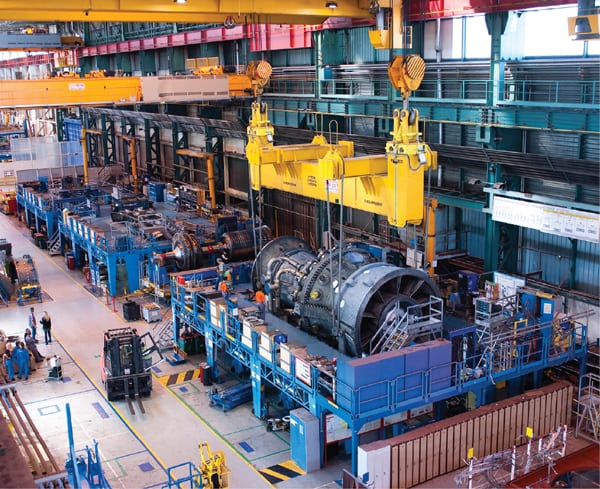 |
| 3. Advanced combustion turbine. The FlexEfficiency 50 is designed around the 9FB combustion turbine that has many years of operating experience. Portions of the 9FB have been redesigned to accommodate the stress of fast ramp rates while increasing component life and maintenance intervals. A completed 9FB combustion turbine is shown undergoing final testing on GE’s Greenville, S.C., shop floor. Courtesy: GE Energy |
The power turbine is a four-stage design, evolving from the earlier H System designs with new materials but without steam or hybrid cooling. In sum, GE Energy expects the new design to significantly extend major inspection intervals and increase rotor life by 50%. The cold end of the CT directly connects to one side of the generator in the FlexEfficiency 50 single-driveline configuration, and the CT axial exhaust connects to the heat recovery steam generator (HRSG).
Steam Turbine. The 180-MW steam turbine, model 109D-14, leverages the HEAT (High Efficiency, Advanced Technology) steam path technology introduced in 2002. The three-casing (separate high-, intermediate-, and low-pressure sections) design using inlet steam conditions of 165 bar/600C/600C produces a shaft efficiency greater than 40%. The turbine internals use shorter bearing spans and improved clearance control to support higher ramp rates. Different last-stage blades can be selected for standard and air condensing applications. Uniquely, the steam turbine features a single-side, two-flow exhaust, which allows locating the condenser at ground level, reducing construction cost. The steam turbine connects to the opposite side of the generator through a self-synchronizing clutch.
Generator. The 550-MW double-ended generator uses one-piece frame construction to simplify installation and alignment. The generator also uses modular gas, seal oil, and stator cooling water systems to reduce construction complexity.
Heat Recovery Steam Generator. HRSG manufacturers have spent the past decade upgrading designs to handle the internal stresses developed when units are cycled, from using more exotic materials to increasing drum wall thickness. In older HRSG designs, unplanned cycling introduced unanticipated stresses in many regions of the HRSG—such as steam drum penetrations, reheat steam pipes, and downcomers—reducing component life. The FlexEfficiency design has addressed these life-limiting HRSG issues based on detailed transient analysis simulations and long industry experience. For example, additional, smaller drum penetrations reduce the magnitude of the stresses experienced during high ramp rate evolutions. A stack damper bottles up the thermal energy in the HRSG, shortening the time require for the next startup.
Advanced Controls. GE Energy’s Mark VIe digital control system synchronizes plant operations, including load change transients and efficient part-load operation. The “plug and play” Ethernet-based digital network uses fieldbus technologies that are finding favor in the most recent plant builds because of their ease of installation, calibration, and online health-monitoring capability. The sophisticated plant control system allows true one-button startup of the entire plant based on a user-selected start profile.
Development Tests Pending
GE Energy is investing $170 million to construct a full-speed, full-load testing facility in Greenville, S.C., to replicate actual operating conditions and wring out unanticipated problems before the first plant is constructed. This facility is scheduled to begin operation in 2014 and be ready for full demonstration of the FlexEfficiency 50 capabilities the following year.
GE Energy reports two purchase orders for the FlexEfficiency 50. The first buyer is China’s Harbin Electric Co., which signed a letter of intent in June for four 9FB CTs, two with FlexEfficiency technology. The final purchase order is scheduled for the end of 2013. The second order received was from Turkish plant developer MetCap Energy Investments for a combination solar/natural gas–fired plant, to be built in Karaman, Turkey. The 530-MW plant (510 without the solar component) will be integrated with eSolar concentrated thermal tower technology. According to Paul Browning, who runs the GE Energy thermal products group, “This will be a power plant that combines wind, natural gas, and integrated combined technology under one roof.” The plant is expected to begin service in 2015.
New Terminology Proposed
Some regulating plants are added to the grid in blocks of load such that individual turbines or engines do not operate at part load for long periods. Today, expect regulating plants to spend the majority of operating hours either ramping up or ramping down in load. These new operating regimes will surely require new methodologies for determining best available control technology, as full-load emissions are no longer descriptive of the plant’s hourly or annual emissions.
NorthWestern Energy grappled with how to characterize emissions from a plant that was designed exclusively for regulating service when building its new Dave Gates Generating Station (see p. 54). In the end, the regulating authorities agreed that a simulation of all expected operating scenarios could be used to arrive at expected emissions that then became the permit limits. The NorthWestern Energy experience may be the exemplar for setting future emissions limits for regulation plants.
GE Energy also recognizes that commonly used operating statistics, such as availability and reliability, fail to properly express operations of a regulation plant. GE suggests a new term: FlexEfficiency (FE). The suggested definition of FE for a regulation plant is “profitable annual MWhrs divided by annual fuel consumption.”
GE suggests that a typical combined cycle plant, with about 200 starts/year with a mix of baseload and cycling conditions, will have an FE of about 56%; the FlexEfficiency 50 is expected to have about 58.5%. Your mileage may vary.
Will FlexEfficiency catch on in the industry? I doubt it, for all the obvious competitive reasons. Instead, how about using the term “regulating efficiency”? Then many other common performance metrics could be modified by adding the descriptor “regulating,” such as regulating availability factor, regulating reliability factor, or regulating load factor. Useful metrics that describe the operation of a hybrid combined cycle-concentrated solar project are difficult to conceive. In the meantime, metrics for a regulation plant alone will keep the analysts who maintain and update the North American Electric Reliability Corp.’s Generating Availability Data System databases busy for years.
— Dr. Robert Peltier, PE is POWER’s editor-in-chief.







